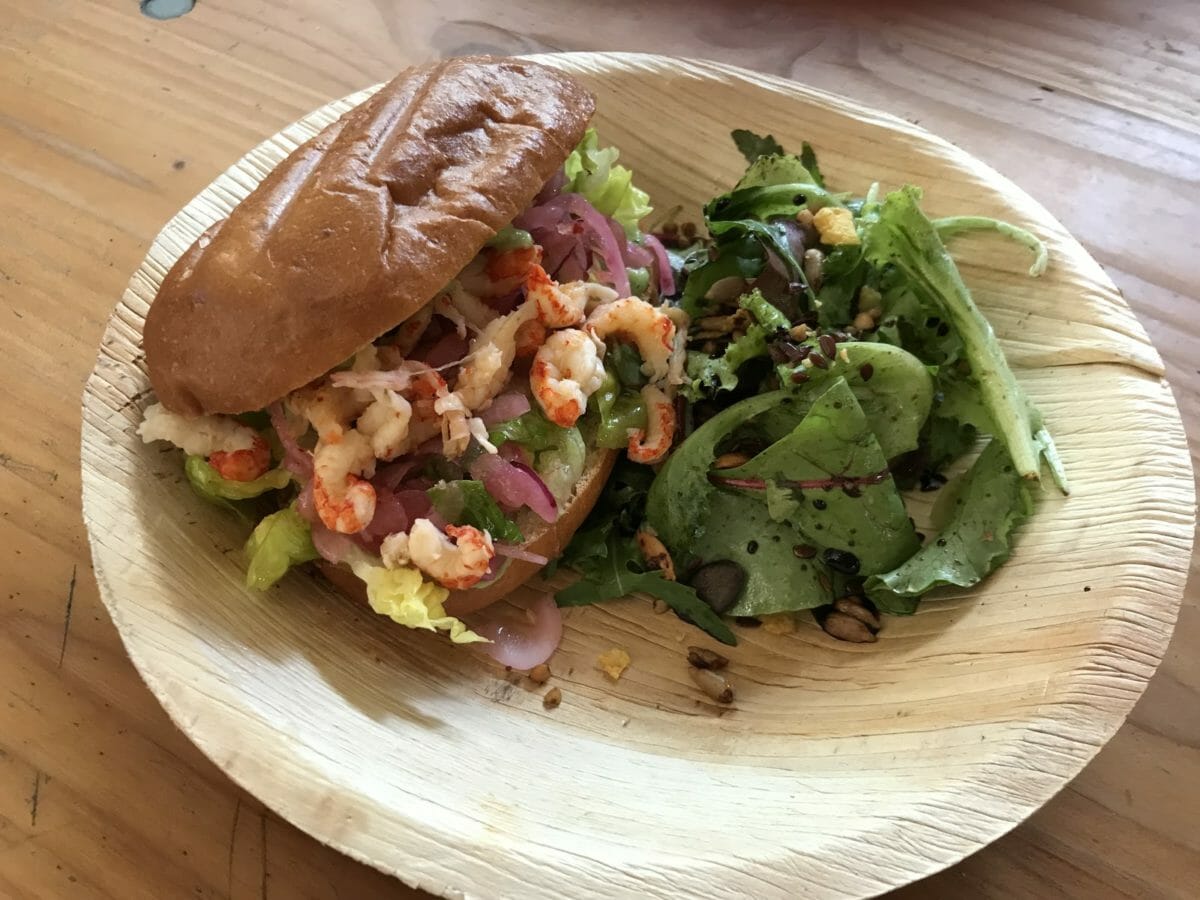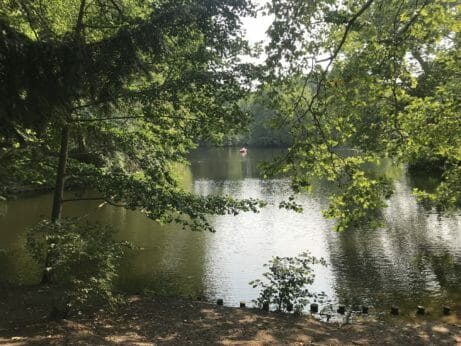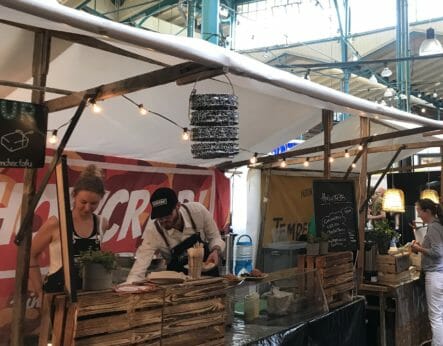How Do You Eradicate an Invasive Crayfish in Berlin? Crab Rolls and Bouillabaisse
It’s about rebalancing the waterways, one lunch at a time.
How Do You Eradicate an Invasive Crayfish in Berlin? Crab Rolls and Bouillabaisse
It’s about rebalancing the waterways, one lunch at a time.

Holycrab! at Markthalle Neunis a food stall dishing out tasty invasive species like this Berlin crab roll.Susannah Edelbaum
Berlin’s long-term residents have been dealing with a rapid influx of gentrifying newcomers — and the rapacious developers who love them — for nearly a decade. Less publicized are the city’s aquatic denizens, which have been facing a foreign onslaught of their own. How the small red Louisiana crayfish first made it into the waterways of the city’s elegant central park, Tiergarten, is inconclusive. But since Procambarus clarkii was first spotted in 2015, the rapidly multiplying crustacean has been hungrily and problematically feeding on native crayfish, lake plant life and the eggs and flesh of many of the 42 species of fish that comprise the rest of its underwater neighbors.
“We hope we can abolish all of them because they are very aggressive,” explains Derk Ehlert, wildlife adviser to the Berlin Senate. The city first took action against the Louisiana crayfish in 2016, moving large eels to Tiergarten’s waterways with the hope that they would eat most of the species. “Unfortunately, it wasn’t possible because the crayfish were already so numerous.” In 2017, observers began to witness the crayfish marching en masse down park paths — smaller in stature than the Easyjetsetters who persistently swarm the city but just as difficult to dislodge from the landscape. The city health department tested the crustaceans, which turned out to be perfectly safe to eat, and Berlin made licenses available to any local anglers who were interested in trapping them. A lone fisherman named Klaus Hidde took the city up on the offer (and he remains the only one) and caught 3,000 on his own between late April and the end of September, when the water is warm enough to get to the animals and before the lakes are covered in leaves. The following year, Hidde trapped 40,000 across Tiergarten and the Britzer Garten, more than 12 kilometers away, where the crayfish have taken up a secondary residence.

The Louisiana native’s origins in Berlin are murky, but Ehlert speculates that they were released from a home aquarium or rejected by a restaurant and disposed of in a Tiergarten pond. With any luck, though, other outlets that are more willing to cook the crustacean will help bring their numbers under control.
So far, only two Berlin restaurants, Fisch Frank and Grand Tang, have consistently kept Hidde’s catch on their menus. But in May, they were joined by Holycrab!, a catering business and roving food stand built around eating the crayfish. Two of three of its founders, Juliane Bublitz and Lukas Bosch, aren’t restaurateurs but innovation consultants, with backgrounds in design thinking. They read about the crayfish problem in the newspaper. “Invasive species lead to shrinking biodiversity, and states spend a lot of money to get rid of them,” says Bublitz.
As for the issue in their own city, they wondered how crazy it was that nobody was doing anything about it. The pair coined the idea for an “invasive delicatessen” over a glass of wine and connected with the chef, Andreas Michelus, who specialized in cooking meat and fish at the Hotel de Rome at the time. The Hotel de Rome and Hotel am Steinplatz, where Michelus previously worked, are among the city’s five-star hotels and have “the best kitchens in Berlin, which was important for us,” says Bublitz. “We wanted to not only do something innovative in terms of ingredients but also produce something people would like.”
Holycrab! is organized around the idea of hedonistic sustainability, a concept that originated in architecture and is perhaps best exemplified by Amager Bakke, the massive ecological waste-to-energy plant that was welcomed by Copenhagen with open arms, thanks to a ski slope known as Copenhill that occupies the expanse of the roof. “You’d think that if you want to act sustainably in food, you need to reduce what you eat, reduce the amount of meat you eat or don’t eat any meat at all,” says Bublitz. A concept like Holycrab! lets diners “have fun acting sustainably because you need to eat as much as possible to rebalance the ecosystem.” Michelus’ Berlin crab roll, his most popular dish, is delicious and sees Holycrab! going through 40 to 80 kilograms of the mild, slightly sweet crayfish every week at private caterings and their stand at Street Food Thursday, a weekly food vendor market held in a historic city market hall. Historically, the Berlin palate isn’t big on crustaceans, but customers from the United States, Russia and Ukraine are readily tucking into the fare at Holycrab!, says Bublitz, as are those who think consuming invasive species is simply the next logical step in local, sustainable dining.

Bublitz isn’t too worried about running out of invasive crayfish. Besides the fact that the species is currently too numerous to realistically envision that possibility, Michelus prepares vegetarian dishes made from Rettengemüse, “rescued” vegetables that are typically trashed because they don’t meet the European Union’s aesthetic standards. In addition, the chef is already cooking up two other invasive crustaceans, Chinese mitten crabs and spinycheek crayfish, which occupy waterways outside Berlin. “If we’re lucky, we can eradicate one species, like the Louisiana crayfish, in Tiergarten,” says Bublitz. “But then there are all the others.”
Follow us
This work is licensed under a Creative Commons Attribution-NoDerivatives 4.0 International License.
Want to republish a Modern Farmer story?
We are happy for Modern Farmer stories to be shared, and encourage you to republish our articles for your audience. When doing so, we ask that you follow these guidelines:
Please credit us and our writers
For the author byline, please use “Author Name, Modern Farmer.” At the top of our stories, if on the web, please include this text and link: “This story was originally published by Modern Farmer.”
Please make sure to include a link back to either our home page or the article URL.
At the bottom of the story, please include the following text:
“Modern Farmer is a nonprofit initiative dedicated to raising awareness and catalyzing action at the intersection of food, agriculture, and society. Read more at <link>Modern Farmer</link>.”
Use our widget
We’d like to be able to track our stories, so we ask that if you republish our content, you do so using our widget (located on the left hand side of the article). The HTML code has a built-in tracker that tells us the data and domain where the story was published, as well as view counts.
Check the image requirements
It’s your responsibility to confirm you're licensed to republish images in our articles. Some images, such as those from commercial providers, don't allow their images to be republished without permission or payment. Copyright terms are generally listed in the image caption and attribution. You are welcome to omit our images or substitute with your own. Charts and interactive graphics follow the same rules.
Don’t change too much. Or, ask us first.
Articles must be republished in their entirety. It’s okay to change references to time (“today” to “yesterday”) or location (“Iowa City, IA” to “here”). But please keep everything else the same.
If you feel strongly that a more material edit needs to be made, get in touch with us at [email protected]. We’re happy to discuss it with the original author, but we must have prior approval for changes before publication.
Special cases
Extracts. You may run the first few lines or paragraphs of the article and then say: “Read the full article at Modern Farmer” with a link back to the original article.
Quotes. You may quote authors provided you include a link back to the article URL.
Translations. These require writer approval. To inquire about translation of a Modern Farmer article, contact us at [email protected]
Signed consent / copyright release forms. These are not required, provided you are following these guidelines.
Print. Articles can be republished in print under these same rules, with the exception that you do not need to include the links.
Tag us
When sharing the story on social media, please tag us using the following: - Twitter (@ModFarm) - Facebook (@ModernFarmerMedia) - Instagram (@modfarm)
Use our content respectfully
Modern Farmer is a nonprofit and as such we share our content for free and in good faith in order to reach new audiences. Respectfully,
No selling ads against our stories. It’s okay to put our stories on pages with ads.
Don’t republish our material wholesale, or automatically; you need to select stories to be republished individually.
You have no rights to sell, license, syndicate, or otherwise represent yourself as the authorized owner of our material to any third parties. This means that you cannot actively publish or submit our work for syndication to third party platforms or apps like Apple News or Google News. We understand that publishers cannot fully control when certain third parties automatically summarize or crawl content from publishers’ own sites.
Keep in touch
We want to hear from you if you love Modern Farmer content, have a collaboration idea, or anything else to share. As a nonprofit outlet, we work in service of our community and are always open to comments, feedback, and ideas. Contact us at [email protected].by Susannah Edelbaum, Modern Farmer
August 18, 2019
Modern Farmer Weekly
Solutions Hub
Innovations, ideas and inspiration. Actionable solutions for a resilient food system.
ExploreExplore other topics
Share With Us
We want to hear from Modern Farmer readers who have thoughtful commentary, actionable solutions, or helpful ideas to share.
SubmitNecessary cookies are absolutely essential for the website to function properly. This category only includes cookies that ensures basic functionalities and security features of the website. These cookies do not store any personal information.
Any cookies that may not be particularly necessary for the website to function and are used specifically to collect user personal data via analytics, ads, other embedded contents are termed as non-necessary cookies.
Great idea. Feeds people and reduces an invasive species. Hope to see more of this, world-wide.